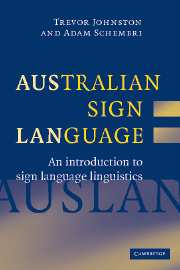Book contents
- Frontmatter
- Contents
- Acknowledgements
- Conventions for sign notation
- 1 Signed languages and linguistics
- 2 Auslan in social context
- 3 Auslan and other signed languages
- 4 Phonetics and phonology: the building blocks of signs
- 5 Morphology: sign formation and modification
- 6 Lexicon: the structure of Auslan vocabulary
- 7 Syntax: the structure of sentences in Auslan
- 8 Semantics and pragmatics: sign meaning and sentence meaning
- 9 Discourse: structure and use above the sentence
- 10 Issues in the study of signed languages
- References
- Index
4 - Phonetics and phonology: the building blocks of signs
Published online by Cambridge University Press: 02 December 2009
- Frontmatter
- Contents
- Acknowledgements
- Conventions for sign notation
- 1 Signed languages and linguistics
- 2 Auslan in social context
- 3 Auslan and other signed languages
- 4 Phonetics and phonology: the building blocks of signs
- 5 Morphology: sign formation and modification
- 6 Lexicon: the structure of Auslan vocabulary
- 7 Syntax: the structure of sentences in Auslan
- 8 Semantics and pragmatics: sign meaning and sentence meaning
- 9 Discourse: structure and use above the sentence
- 10 Issues in the study of signed languages
- References
- Index
Summary
One of the defining features of language is that the symbols that are used in language can be broken down into smaller discrete parts or segments (Hockett, 1960). In this chapter, we explore in detail how segmentation applies to the signs used in a signed language. As linguistics has traditionally focused on the study of speech, many of the key concepts and much of the terminology used in the study of signed languages have been adapted from the description of spoken languages. We thus begin with a brief outline of the internal structure of words in spoken languages. We then move on to discuss the internal structure of signs, how they may be classified into different types based on their formational characteristics, and how their structure is influenced by a number of constraints.
The internal structure of words
The words in a spoken language like English are not produced simply as a random combination of sounds, but are made from a limited set of sounds. Sounds from this limited set are used to build all the hundreds of thousands of words in the English language. In traditional models of spoken language phonology, these sounds act as the smallest contrastive units of the language, because a change in even one of these sounds can change the meaning of the word, as in the contrast between the words pet versus bet. Following Bloomfield (1933), the smallest segments of sounds that are used to distinguish two words have come to be known as phonemes. The number of phonemes varies from language to language, although most languages appear to have between 20 and 40 (Crystal, 1997).
- Type
- Chapter
- Information
- Australian Sign Language (Auslan)An introduction to sign language linguistics, pp. 77 - 116Publisher: Cambridge University PressPrint publication year: 2007



